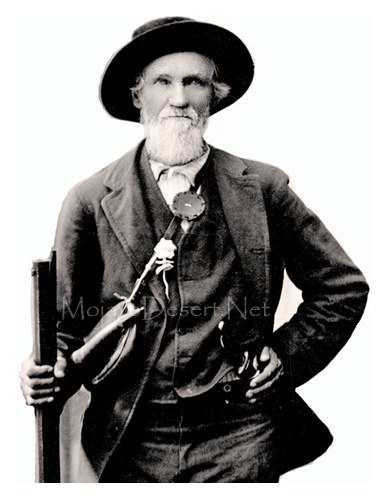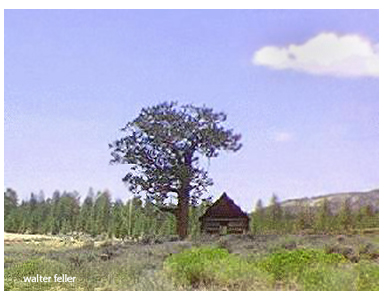William F. Holcomb
William Francis Holcomb, a member of the Society of California Pioneers of San Bernardino County, and the discoverer of gold in the valley which bears his name, was born in Indiana in 1831, but his parents moved to Will County, Illinois, in his infancy, where they lived till he was eight years old. They then went, in 1839, to Iowa and located in Portland, Van Buren County Iowa. His father having died, his mother moved with her family in 1845 up into Wapello County and took up a piece of Government land. The same year his oldest brother, Stephen Holcomb, went to Oregon, where he still resides near the city of Portland. Stephen achieved considerable celebrity as an Indian scout in the employ of the Government out on that then wild frontier.After eleven years’ residence in the Hawkeye State, the subject of this memoir left Ottumwa, Iowa, on the 5th of May 1850, for California, In crossing the plains his company narrowly escaped a conflict with the Indians several times, but experienced nothing more serious than slight skirmishes. They came via Fort Laramie, Green River and Sublet’s cut off. In crossing Green river, the ferryboat sank and Mr. Holcomb’s wagon and the entire contents, including his boots, which he had taken off to assist in getting their cattle across, were lost. Securing a mule to pack their little remaining luggage, he and a companion proceeded on their perilous journey, Mr. Holcomb being barefooted, and he never put his feet in shoes or any other footwear from that time (July) until the next December. About seventy-five miles from Salt Lake they sold their mule for $50 and continued on with only such things as they could carry. Their sufferings from hunger and fatigue were at times almost beyond human endurance or belief. On one occasion, when near the sink of the Humboldt river, for six days and nights they had no other food but rosebuds, and for three days of the time were without even those!
As they were starting to cross the fifty-five mile desert from the Humboldt to the Carson river in this famishing condition, they met with a piece of good fortune which seemed like a special providence. One morning lying square in the middle of the trail they found a large sack filled with provisions, including coffee and several substantial edibles prepared and put up in a tempting style by loving hands for some member of the last preceding emigrant train. Opening the sack, Mr. Holcomb and his comrade took out a quantity of such articles as they deemed best for their use, then tied it up and left it with the remainder of its contents for the next hungry traveler. On reaching Carson River they found plenty of food and water, but were so utterly exhausted and weak that their stomachs loathed food, and, sinking down half unconscious upon the side of the trail, they slept until sufficiently rested to begin to take nourishment in small quantities.
Remaining at Carson river until their strength was pretty fully recovered, they resumed their journey, reaching Hangtown -now Placerville -on August 28, 1850. Mr. Holcomb spent ten years in the mines in that part of the State, and although he did a great deal of hard work he only met with moderate success, making little more than current expenses. He first visited San Bernardino in February 1860, a horse and a gun comprising his worldly possessions at that time. He and his partner went on up into the mountains east of the city, prospecting in Bear valley and beyond, and while there he explored a small valley on the headwaters of the Mojave River, and discovered a gold mine, which for a time created considerable excitement and was quite extensively worked, there being 1,500 people or more in the valley in 1861. The richest portion of the placer diggings was soon worked out, and the excitement subsided; it is reported, however, that the mines are about to be re-opened.
In 1863-’64 Mr. Holcomb spent a year in Arizona, during which he obtained a small interest in the Vulture mines, which he subsequently sold for $500. On returning from Arizona he settled in San Bernardino, which has been his home ever since. In 1880 he purchased the place of fourteen acres on the corner of I street and the Base Line road, where he and his family now reside, paying $1,400 for it. He has erected a frame dwelling and planted about half the land to deciduous fruit trees, now in bearing. He has refused $14,000 for the property.
In 1872 Mr. Holcomb was elected County Assessor on the Republican ticket, and was re-elected, serving in that office eight years. On retiring he spent seven months in Arizona as superintendent of a mining ditch for the Tombstone Mill and Mining Company. In 1882 he was nominated and elected County Clerk by a majority of about 240 votes over A. F. McKenney, then holding the office and a very popular man. Mr. Holcomb was the first Republican clerk ever elected in San Bernardino County. He was re elected as his own successor by a much larger majority over J. H. Boyd as the Democratic candidate. During his first term as County Clerk Mr. Holcomb served also as ex-officio County Recorder, County Auditor, Clerk of the Board of Supervisors and Clerk of the Board of Equalization. At the close of this term the clerk’s office was segregated from the others.
In 1860 Mr. Holcomb married Miss Stewart in San Bernardino, a native of Illinois. They have a family of five sons and two daughters, all but two married and living in San Bernardino, and all have homes presented to them by their father. Even the two minor children are thus provided for Mr. Holcomb is justly proud of his family; and few men are as well satisfied with the results of a laborious life, or review the retrospect with as much pleasure. He has for many years enjoyed the reputation of being one of the most successful hunters on the Pacific Coast, and has probably captured more grizzlies than any other man in California. And, as he has retired from active business and still loves the sport, he spends a portion of every season with “old boys” in the mountains hunting and fishing. Mr. Holcomb is a member of the Society of California Pioneers of San Bernardino County and of the “Old Boys’ Hunting Club.” Having won the prize over about fifty competitors in a Christmas hunt in 1888, the Old Boys’ club presented him with a beautifully designed and engraved silver cup, which he values highly as a keepsake.
History of San Bernardino & Riverside Counties by John Brown Jr. & James Boyd

"On our arrival at Los Angeles in 1859, we found everything quiet, no work to be had, what to do, we, Jack Martin, my old hunting and mining companion, and I did not know."
~ William Holcomb
Bears in Bear Valley
Holcomb Valley Gold
Holcomb Valley

Holcomb Valley cabin